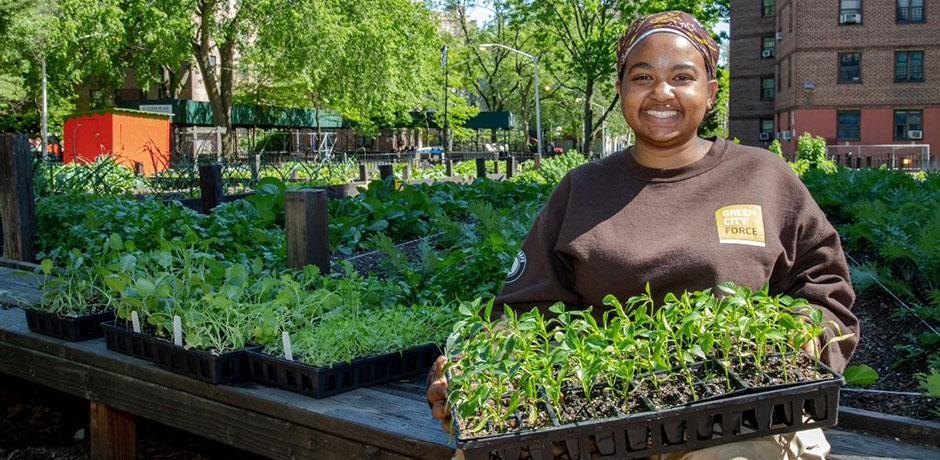The 5-Second Trick For City Blooming
The 5-Second Trick For City Blooming
Blog Article
City Blooming Fundamentals Explained
Table of ContentsCity Blooming Fundamentals Explained10 Easy Facts About City Blooming ShownSome Ideas on City Blooming You Should KnowSome Known Incorrect Statements About City Blooming The Single Strategy To Use For City Blooming
Interested in expanding food for sale in the City of Chicago? Below is a listing of often asked inquiries regarding the guidelines and regulations that cultivators must take into consideration when planning an urban farming job.
The zoning amendment does not change any type of other codes taking care of composting, structure licenses, purchasing or renting City possessed residential or commercial property, organization licenses or ecological contamination. There are existing codes that manage these concerns and they stay in complete effect and might be relevant to your task. Neighborhood yards are generally had or handled by public entities, public organizations or community-based companies and kept by volunteers.
Urban farms grow food that is meant to be sold, either on a not-for-profit or for-profit basis. As a result of their industrial objective, city ranches call for a business license. Yes. A neighborhood garden is enabled to sell excess generate that was grown on website if the sales are accessory or subservient to the garden's primary objective explained above.
6 Simple Techniques For City Blooming
The amount of compost material can not exceed 25 cubic lawns at any kind of offered time according to the standards in 7-28-715 of the City's Municipal Code. Since the soil at many brand-new garden websites requires modifying, garden compost, soil, wood chips, or other products can be acquired to create or boost the expanding area.

If a structure license is needed then the hoophouse will be considered an accessory structure. You can figure out even more concerning the structure permit requirements by speaking to the Division of Buildings. The 25,000-square-foot size limit is meant to avoid a solitary neighborhood yard from dominating a provided block or interfering with the block's existing residential or business character.
The restriction does not relate to yards found in Public Open Room (POS) districts. Can there be greater than one community yard that is 25,000 square feet on a single block? Yes. The size restriction applies to specific yards, not to individual blocks. No. Secure fencing is not needed, nonetheless, yards that have big parking lot might be required to set up fencing or various other landscaping features.
10 Simple Techniques For City Blooming
B1 & B2 areas need that all commercial usage activities be performed indoors. R districts limit industrial task. The regulations mirror the purpose and intent of the Zoning Code. Is fence needed for city ranches? Yes. Fences may be required, together with landscaping and screening, for sure car park areas and exterior job or storage areas depending on place and the particular task happening.
Yes. Urban ranches require structure permits and zoning authorizations before construction. Other kinds of city evaluation may be needed depending upon particular structures, activities, size, landscaping, licensing, public health and stormwater monitoring concerns. Much of these demands are determined in the job layout or permitting procedure, nevertheless, the applicant may be liable to individually determine particular licenses or permits that may be required.
Yes. The sort of permit is established by what is taking place at the website. The Division of Service Affairs and Consumer Security can assist identify the particular kind of company license that's required. Yes. Off street car parking is needed for many business jobs in Chicago. The required variety of garage is based upon the variety of workers working with website and not the square footage of the growing area.
Fascination About City Blooming

A metropolitan ranch can offer garden compost product generated on site, however, the procedure needs to comply with the regulations in 7-28-715 of the Chicago Municipal Code. Aquaponic systems are enabled inside on urban ranches in several zoning districts.
As much as five hives or colonies of honey bees might be kept as an accessory usage. Beekeepers must sign up with the Illinois Division of Agriculture. To learn more regarding the proposed zoning amendment you might speak to the Department of Housing and Economic Growth, Bureau of Planning and Zoning at 312.744.8563.
Farming in cities and city locations A city ranch in Chicago. Urban farming describes various methods of growing. https://my-store-faa5b0.creator-spring.com/, processing, and distributing food in metropolitan areas. The term also puts on the location activities of animal husbandry, tank farming, beekeeping, and cultivation in a metropolitan context. Urban farming is distinguished from peri-urban agriculture, which happens in backwoods at the edge of residential areas.
City Blooming Things To Know Before You Get This
, that seek to develop social networks founded on a shared principles of nature and community holism. These networks can develop by means of formal institutional assistance, ending up being incorporated into regional community preparation as a "shift town" activity for sustainable urban growth.
In either instance, the extra direct access to fresh vegetable, look at here now fruit, and meat items that may be understood with city agriculture can enhance food safety and food safety and security while decreasing food miles, causing lower greenhouse gas exhausts, thereby adding to climate change mitigation. A few of the initial proof of city agriculture comes from Mesopotamia.
Report this page